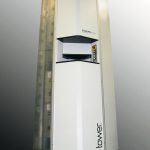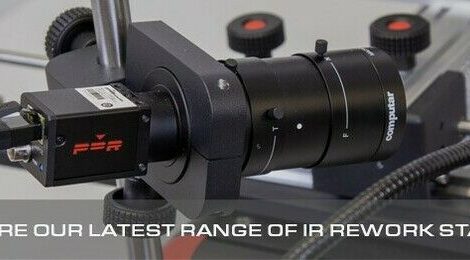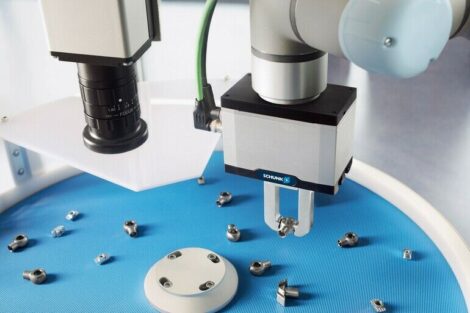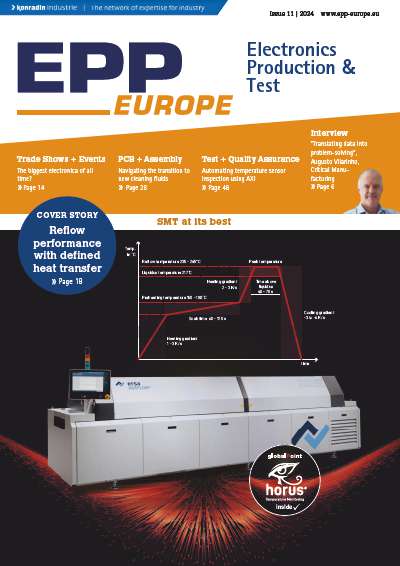SMD components with high moisture sensitivity level (MSL) ratings cause major logistical efforts, waste of energy and consume expensive dry packs. The Tower SMD storage system reduces these costs and efforts with a dry, controlled storage environment and automatic handling.
Adrian Schärli, Azular GmbH for Essemtec AG, Switzerland
Electronics manufacturers do not like popcorn, specifically the most feared popcorn effect that is caused by humidity in SMD components. This humidity expands during reflow soldering and causes cracking and delamination in components. Unfortunately, the problem generally is visible only after soldering, and often only when the product is in use.
Manual control is errorprone
The MSL classification characterizes how sensitive a component is to humidity. MSL classes are defined by the JEDEC standard J-STD-020D-01. Each MSL class has its floor lifetime, which is the time that the component may be processed when it is outside a dry pack and exposed to a relative humidity of more than 5 percent. The calculation of the remaining floor lifetime is a complicated procedure. When a dry pack is opened, the operator must note the exact date and time of opening. After usage, the component should immediately be dry-packed and vacuum-sealed again and the exact time must be noted. The remaining floor lifetime is the difference between the original floor lifetime reduced by the open-time. Floor lifetime depends on the MSL class and the relative humidity in production.
The above description makes clear that security against the popcorn effect depends on the operators’ reliability to note the correct time. If the notification is forgotten or the exact time is estimated, all following calculations will be wrong. Therefore, most manufacturers chose choose preventive baking, a procedure that minimizes risk but also has its disadvantages.
The original floor lifetime can be regained by baking components. Storing components for 192 hours at 40 °C or 24 hours at 125 °C can reduce the humidity to a low enough level that the popcorn effect should not appear during reflow soldering. After baking, the components must be sealed in a dry pack together with a humidity indicator card (HIC). The floor lifetime resets as if the pack was never opened. This process is secure, but the price is of material, logistics and energy is high. Furthermore, the temperature load can reduce the lifetime expectation of sensitive components.
Dry storage with automatic control
However, there is an alternate way to keep components safe without dry packs: storing them in an atmosphere with less than 5 percent relative humidity. In such an environment, components do not absorb humidity and the floor lifetime lapse is interrupted (compare JEDEC standard 033b, chapter 5.3.3.2 Dry Cabinet at 5 % RH). This is the concept of the Essemtec’s Tower, the automatic SMD storage system.
The Tower is a compact, sealed storage system in which a robot handles component reels and trays. There is only one way in and out through a lock. Therefore, each stock movement is registered. Furthermore, storage conditions are controlled, monitored and recorded. The interior of the Tower seals almost hermetically. A dehumidification unit is installed to keep the relative humidity below 5 percent at all times. Optionally, the Tower can be flooded with nitrogen. The Tower knows exactly how long components are outside the controlled storage atmosphere and it knows the conditions inside. Therefore, it can calculate the exact remaining floor lifetime for each individual component. The Tower is so compact and easy to operate that it can be installed on the production floor next to the pick-and-place machines or the feeder set-up area. As such, logistics become much simpler: Instead of resealing in dry packs, a reel or a tray is just placed in the Tower where it is automatically picked up and stored by the robot. Simultaneously, the floor lifetime lapse is interrupted and MSL sensitive components are saved.
Age is the priority
The Tower manages all components according to the first in, first out (FIFO) principle. This is possible because every component reel or tray is identified with a unique code. With this code, all component data are stored including manufacturer data, expiry dates and MSL classification. The storage management software makes sure that if more than one reel with identical components is available, the oldest one always will be used. This is a great advantage compared to other storage systems where the operator decides which components will be used: The Tower is fully automatic and provides only the correct reel or tray. If components expire or if the remaining floor lifetime is below a minimum value, the Tower prevents them from being used for production. It informs the operator to initiate further action.
This information gap can be corrected by connecting the Tower to the pick-and-place machine. The placement machine then automatically can send consumption and reject data to the Tower. Its database is automatically updated. Now a production planning system such as the MIS from the company requests components for a specific job, the Tower can automatically decide how many and which reels are required and can give them to the operator as well as communicate with ERP systems for exchanging stock data. Which system finally manages the data depends on the customer’s infrastructure the Tower features an open interface for the data exchange.
Multiple protection
A single Tower, whic occupies only a surface of one square meter, can store up to 546 component reels or 294 trays. The Tower’s height is only 2.2 meters, so it fits into every production environment. For more storage capacity, multiple Towers can be clustered and controlled by central software. Inside the tower, components are protected against humidity, ESD and even material loss. The latter often happens if multiple people have access to the same storage. How much a Tower can help in such a situation is shown by the following example of a customer’s development department: Formerly, all components were stored in a simple shelf. Without control of stock input and output, there was continuous component anarchy. The production claimed a constant lack of components because many reels were taken for trials, development or repairs and not brought back. After the installation of the Tower, the situation changed immediately. The tower registers every storage movement and requires user identification. Now, every user with access rights can take out a reel and even find it more quickly than before. If the production requires a component, they know where to find it. But even this occurs more seldom than before because component handling is so simple that components are brought back more quickly and voluntarily.
The Tower ensures SMD production quality by only using components that are not expired and that have sufficient remaining floor lifetime. The system increases productivity, reduces set-up time and enables an error-free production by simplifying and automating the logistics. Furthermore, the Tower relieves machine operators, stock workers and the repair department, thereby reducing production costs and increasing production capacity and profits.
zUSAMMENFASSUNG
Der Tower, ein automatisches SMD-Lagersys-tem, nimmt bis zu 546 Bauteilrollen auf nur einem Quadratmeter auf und lässt sich modular erweitern. Die Ein- und Auslagerung der gegen Feuchtigkeit geschützten SMD-Rollen und Paletten erfolgt vollautomatisch mittels der Tower-Steuerung.
L’équipement permet de stocker jusqu’à 546 rouleaux de composants sur une surface de seulement un mètre carré et peut être complété de façon modulaire. L’entreposage et la mise hors dépôt des rouleaux et des palettes de CMS protégés de l’humidité se fait entièrement automatiquement grâce à la commande de la tour.
Share:













